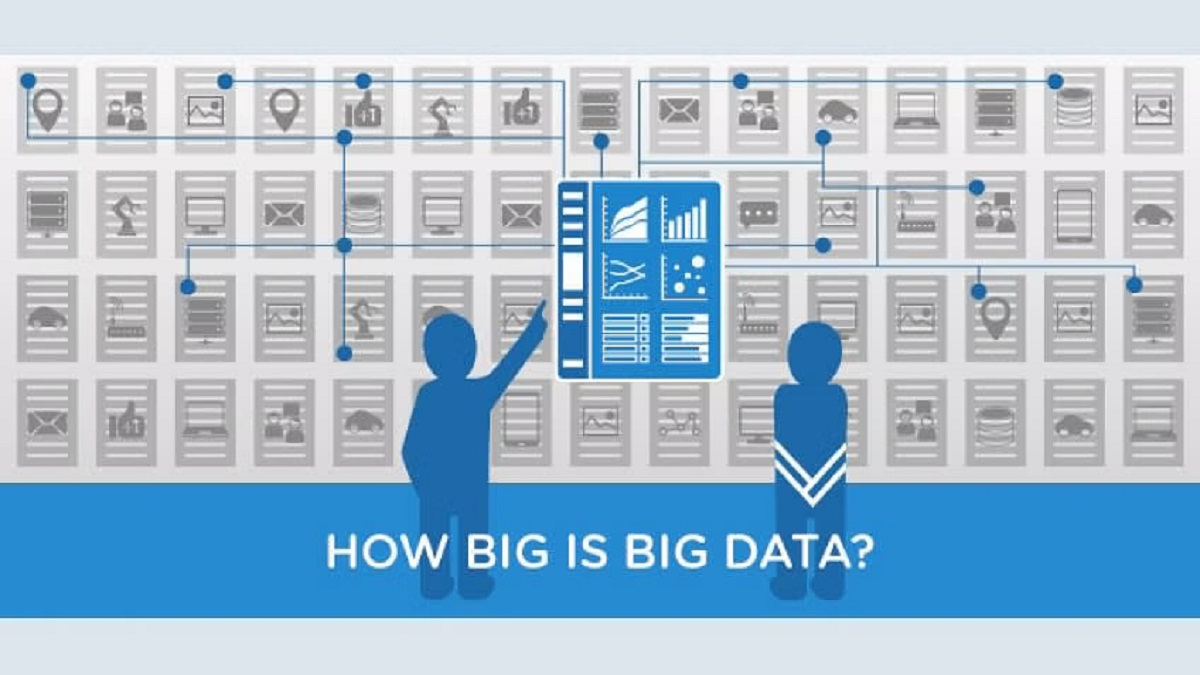Introduction
Big Data as a Service (BDaaS) has emerged as a game-changing solution in the data analytics space. With the exponential growth of data in today’s digital age, organizations are seeking innovative ways to manage and extract value from large and complex datasets. BDaaS offers a compelling solution by providing on-demand access to powerful analytics tools and infrastructure, eliminating the need for organizations to invest in costly hardware and software.
BDaaS is a cloud-based service that allows businesses to store, process, analyze, and derive meaningful insights from vast amounts of data. By leveraging the scalability and flexibility of the cloud, organizations can easily access the computational resources necessary to handle big data workloads without the overhead of managing and maintaining physical infrastructure.
The primary goal of BDaaS is to democratize big data analytics, making it accessible to organizations of all sizes and industries. In the past, only large enterprises with substantial budgets and dedicated IT teams could leverage the power of big data analytics. BDaaS has changed this landscape, enabling businesses to harness the potential of big data without the same level of investment.
BDaaS providers offer a wide range of services, including data storage, data integration, data processing, machine learning, and data visualization. These services are typically offered on a pay-as-you-go basis, allowing organizations to scale their usage based on their specific needs and requirements.
The concept of BDaaS revolves around the idea of enabling organizations to focus on extracting actionable insights from their data rather than dealing with the complexities of infrastructure management. By offloading the infrastructure components to a third-party service provider, businesses can accelerate their time to value and gain a competitive edge.
In this article, we will delve deeper into the world of BDaaS, exploring how it works, the benefits it brings to organizations, and the challenges involved in adopting and implementing a BDaaS solution. We will also provide insights into the use cases of BDaaS across various industries and offer guidance on selecting the right BDaaS provider for your business needs.
What is Big Data as a Service (BDaaS)?
Big Data as a Service (BDaaS) is a cloud-based service model that provides organizations with access to the tools, infrastructure, and expertise needed to handle and analyze large volumes of data. BDaaS combines the power of big data analytics with the scalability and flexibility of cloud computing, enabling businesses to leverage the potential of their data without the need for substantial upfront investments in hardware and software.
BDaaS encompasses a range of services that cover the entire data lifecycle, from data storage and management to advanced analytics and visualization. These services are typically offered by specialized third-party providers who have built robust infrastructure and have expertise in data analytics.
One of the key features of BDaaS is the ability to handle large-scale datasets that are difficult to manage using traditional on-premises solutions. The cloud-based infrastructure provided by BDaaS providers allows businesses to scale their data storage and processing capabilities on-demand, ensuring that they can handle increasing volumes of data without any performance limitations.
BDaaS providers offer a wide variety of services to meet the specific requirements of different organizations. These services can include:
- Data Storage: BDaaS providers offer secure and scalable storage options to handle vast amounts of data. This can include structured, unstructured, and semi-structured data.
- Data Integration: BDaaS platforms enable organizations to integrate data from various sources, including internal databases, external APIs, social media streams, and IoT devices.
- Data Processing: BDaaS providers offer powerful data processing capabilities, including batch processing, real-time stream processing, and distributed computing.
- Machine Learning: BDaaS platforms often provide pre-built machine learning models and algorithms, as well as tools for training custom models to uncover patterns and insights from data.
- Data Visualization: BDaaS solutions usually include robust visualization tools that help organizations present and interpret the results of their data analysis in a visual and intuitive way.
By leveraging BDaaS, organizations can overcome the challenges associated with managing and analyzing large datasets. They can focus on extracting valuable insights from their data, enabling data-driven decision-making and gaining a competitive advantage in their respective industries.
In the next section, we will discuss how BDaaS works and the underlying technologies that enable its functionality.
How Does BDaaS Work?
Big Data as a Service (BDaaS) leverages cloud computing technologies to provide organizations with a scalable and flexible platform for storing, processing, and analyzing large volumes of data. The core components of BDaaS include data storage, data processing, analytics tools, and infrastructure.
1. Data Storage: BDaaS platforms offer secure and high-capacity storage solutions to handle big data. Data can be stored in various formats, including structured, semi-structured, and unstructured, allowing organizations to accommodate diverse data sources.
2. Data Processing: BDaaS providers utilize distributed computing models to process large-scale datasets quickly and efficiently. The use of technologies like Hadoop and Apache Spark enables parallel processing, allowing organizations to achieve faster data processing and analysis.
3. Analytics Tools: BDaaS platforms provide a wide array of analytics tools and technologies to extract meaningful insights from the data. These tools can range from basic statistical analysis to advanced algorithms for machine learning, predictive analytics, and natural language processing.
4. Infrastructure: BDaaS solutions are built on top of cloud infrastructure, such as Amazon Web Services (AWS) or Microsoft Azure. These cloud platforms offer the necessary computing power, storage capacity, and network resources needed for handling big data workloads.
BDaaS operates on a subscription or pay-as-you-go model. Organizations can choose the level of service and resources they require and pay for only what they use. This eliminates the need for upfront investments in hardware and software, making it a cost-effective solution for businesses of all sizes.
When an organization decides to adopt a BDaaS solution, they typically follow these steps:
- Data Onboarding: The organization uploads their data to the BDaaS platform. This can involve integrating data from various sources like databases, APIs, or external data feeds.
- Data Storage: The data is stored securely in the cloud-based storage provided by the BDaaS platform. Depending on the platform, the data can be stored in a structured or unstructured manner.
- Data Processing: Organizations can utilize the processing power of the BDaaS platform to perform various data processing operations, such as data cleansing, transformation, aggregation, and feature engineering.
- Data Analysis: Organizations can apply a wide range of analytics techniques and tools provided by the BDaaS platform to uncover valuable insights and patterns from the data. This can include descriptive, diagnostic, predictive, and prescriptive analytics.
- Data Visualization: The results of the data analysis can be visualized using built-in visualization tools or by integrating with third-party visualization software. This helps organizations present their findings in a meaningful and easily digestible format.
By following these steps, organizations can leverage the power of BDaaS to unlock the value hidden in their data and make data-driven decisions that drive business success.
Benefits of BDaaS
Big Data as a Service (BDaaS) offers numerous benefits to organizations seeking to unlock the potential of their data. Here are some key advantages of adopting a BDaaS solution:
1. Cost-Effective: BDaaS eliminates the need for organizations to invest in expensive hardware and software infrastructure. Instead, they can pay for the services and resources they use on a subscription or pay-as-you-go basis. This allows businesses of all sizes to leverage big data analytics without significant upfront costs.
2. Scalability and Flexibility: BDaaS solutions are built on cloud infrastructure, enabling organizations to easily scale their data storage and processing capabilities as their demands grow. Organizations can quickly and seamlessly increase or decrease resources, ensuring they have the necessary capacity to handle fluctuations in data volumes and processing requirements.
3. Rapid Time to Value: With BDaaS, organizations can expedite their time to value by eliminating the time-consuming tasks of setting up and managing infrastructure. They can quickly onboard their data onto the BDaaS platform and unleash the power of analytics to gain insights and make informed decisions.
4. Expertise and Support: BDaaS providers have specialized expertise in managing and analyzing big data. They handle infrastructure maintenance, software updates, and security, allowing organizations to focus on extracting insights from their data. Moreover, BDaaS providers often offer support services and consulting to assist organizations in maximizing the value of their data.
5. Access to Advanced Analytics: BDaaS gives organizations access to a wide range of advanced analytics tools, algorithms, and libraries. This enables them to perform complex analyses, uncover hidden patterns, and make accurate predictions. Organizations can leverage machine learning, natural language processing, and predictive analytics to gain a deeper understanding of their data and make data-driven decisions.
6. Collaboration and Integration: BDaaS platforms facilitate collaboration between teams by providing a centralized data repository and collaborative tools. This allows different teams and stakeholders to work together on analyzing and interpreting data, driving cross-functional insights and improving decision-making.
7. Real-Time Insights: BDaaS enables organizations to process and analyze data in real-time or near real-time. This empowers them to detect and respond to emerging trends, optimize operations, and seize business opportunities promptly.
8. Data Security and Compliance: BDaaS providers prioritize data security and compliance, implementing robust security measures and protocols to protect sensitive data. They adhere to industry regulations and standards, ensuring that organizations can trust the confidentiality, integrity, and availability of their data.
In summary, BDaaS offers organizations the ability to harness the power of big data analytics without the burden of infrastructure management. It provides cost-efficiency, scalability, advanced analytics capabilities, and expert support, empowering organizations to derive actionable insights from their data and drive innovation and growth.
Use Cases of BDaaS
Big Data as a Service (BDaaS) has found applications in various industries and sectors, enabling organizations to derive valuable insights from their data and drive innovation. Here are some prominent use cases of BDaaS:
1. Retail: BDaaS helps retailers analyze customer data to gain a deeper understanding of their preferences, behaviors, and purchase patterns. This information can be used for personalized marketing campaigns, demand forecasting, inventory management, and improving customer experiences.
2. Finance: BDaaS enables financial institutions to analyze vast amounts of transactional data, detect fraudulent activities in real-time, assess credit risk profiles, and develop predictive models for investment strategies. It also helps in regulatory compliance by monitoring transactions and ensuring adherence to anti-money laundering (AML) and know your customer (KYC) regulations.
3. Healthcare: BDaaS facilitates the analysis of patient medical records, genomics data, and clinical trial data. It helps identify disease patterns, enable personalized medicine, improve patient outcomes, and optimize resource allocation. BDaaS also supports medical research by providing access to large datasets for studies and clinical trials.
4. Manufacturing: BDaaS aids manufacturers in optimizing production processes, predicting equipment failures, and improving supply chain management. Analyzing data from sensors and IoT devices allows for proactive maintenance, reducing downtime and improving overall operational efficiency.
5. Transportation and Logistics: BDaaS helps monitor and optimize logistics operations, track fleet movements, and predict demand patterns. It enables route optimization, efficient supply chain management, and real-time tracking for improved delivery accuracy and cost savings.
6. Telecommunications: BDaaS allows telecommunications companies to analyze customer usage patterns, perform sentiment analysis on customer feedback, and optimize network performance. This helps in targeted marketing, detecting network bottlenecks, and improving customer satisfaction.
7. Energy and Utilities: BDaaS assists in analyzing energy consumption patterns, optimizing energy distribution, detecting anomalies in power grids, and predicting maintenance needs. It facilitates energy efficiency management, reduction of energy costs, and improving the reliability of power systems.
8. Government and Public Sector: BDaaS helps government agencies analyze data related to crime patterns, transportation, healthcare, and social services. It enables data-driven decision-making, resource optimization, and the development of smart city initiatives.
These are just a few examples of the diverse applications of BDaaS across industries. The flexibility and scalability of BDaaS make it suitable for organizations of all sizes and sectors. By leveraging the power of data analytics, organizations can gain a competitive advantage, drive innovation, and make informed decisions that impact their bottom line.
In the next section, we will explore the challenges involved in adopting and implementing a BDaaS solution.
Challenges of BDaaS
While Big Data as a Service (BDaaS) offers numerous benefits, there are several challenges that organizations may face when adopting and implementing a BDaaS solution:
1. Data Security and Privacy: With the increased reliance on cloud infrastructure, concerns relating to data security and privacy arise. Organizations need to ensure that proper security measures and protocols are in place to protect sensitive data from unauthorized access, breaches, and data leaks. Compliance with data protection regulations and frameworks is crucial to maintain trust with customers and stakeholders.
2. Data Integration and Quality: Organizations often have data scattered across various systems and formats, making data integration a complex task. Data must be cleansed, transformed, and standardized to ensure consistency and accuracy. Data quality issues, such as incomplete or inconsistent data, can impact the reliability and reliability of insights derived from BDaaS.
3. Technical Expertise: BDaaS solutions require a certain level of technical expertise to effectively set up and manage. Organizations may need personnel with knowledge of big data technologies, data analytics, and cloud computing to fully leverage the capabilities of BDaaS. Acquiring and retaining skilled data scientists and engineers can pose challenges for organizations.
4. Integration with Existing Systems: Integrating BDaaS with existing systems and workflows can be a complex process. Legacy systems and infrastructure may not be easily compatible with the cloud-based nature of BDaaS platforms. Organizations need to plan for seamless integration and ensure compatibility with existing systems to avoid disruptions and data silos.
5. Cost Management: While BDaaS offers cost savings in terms of infrastructure investments, organizations must carefully manage usage and costs. Without proper monitoring and optimization, usage costs can quickly accumulate, leading to unexpected expenses. Organizations need to have proper cost management strategies in place to control spending and optimize resource utilization.
6. Data Governance and Compliance: Organizations need to establish robust data governance policies to ensure ethical and responsible use of data. Compliance with industry regulations and legal frameworks, such as data protection laws and industry-specific regulations, is essential. Implementing data governance frameworks and ensuring data privacy and compliance can be a complex undertaking.
7. Vendor Selection: Choosing the right BDaaS provider is crucial for successful implementation. Organizations must thoroughly evaluate potential providers based on their track record, security measures, scalability, performance, and support services. Vendor lock-in, limited customization options, and contractual obligations can also pose challenges if proper due diligence is not conducted.
8. Data Localization: Organizations operating in certain industries or regions may have specific data localization requirements imposed by regulations. BDaaS providers need to address data residency and compliance requirements to ensure data sovereignty.
Addressing these challenges requires careful planning, stakeholder involvement, and a well-defined roadmap for implementing BDaaS. Organizations must invest in resources and expertise to overcome these hurdles and maximize the benefits of BDaaS for their business operations.
Choosing the Right BDaaS Provider
When adopting Big Data as a Service (BDaaS), organizations need to carefully evaluate and select the right BDaaS provider. Choosing the right provider is crucial for the success of your BDaaS implementation. Here are some factors to consider when selecting a BDaaS provider:
1. Expertise and Reputation: Look for BDaaS providers with a proven track record and expertise in handling big data. Research their reputation in the market, check customer reviews and testimonials, and evaluate their experience in your industry or business domain.
2. Scalability and Flexibility: Assess the scalability of the BDaaS platform to ensure it can accommodate your growing data needs. Consider the flexibility the provider offers in terms of resource allocation, pricing models, and the ability to integrate with your existing systems.
3. Data Security and Privacy: Ensure that the BDaaS provider has robust security measures and protocols in place to protect your data. Ask about their data encryption methods, access controls, backup and recovery procedures, and compliance with data protection regulations relevant to your industry.
4. Performance and Reliability: Evaluate the performance and reliability of the BDaaS infrastructure. Consider factors such as uptime guarantees, data availability, data replication across multiple locations, and the provider’s disaster recovery plans.
5. Data Integration and Interoperability: Assess the BDaaS provider’s ability to integrate with your existing systems, databases, and data sources. Determine if they offer support for various data formats, APIs, and connectors to ensure seamless data integration and interoperability.
6. Analytics Capabilities: Evaluate the analytics tools, algorithms, and libraries provided by the BDaaS platform. Assess if they meet your specific business requirements and if they offer advanced analytics capabilities, such as machine learning and predictive analytics, to derive meaningful insights from your data.
7. Support and SLA: Consider the level of support and service level agreement (SLA) offered by the provider. Ensure that they provide timely technical support, consultation, and training to help you make the most of their BDaaS platform.
8. Data Governance and Compliance: Evaluate how the BDaaS provider handles data governance and compliance. Inquire about their data privacy policies, data residency options, and adherence to relevant industry regulations and compliance frameworks specific to your business.
9. Cost and Pricing: Compare the pricing models of different BDaaS providers. Consider the total cost of ownership, including factors like storage, data transfer, processing, and any additional charges. Evaluate if the pricing aligns with your budget and if there is room for scalability without drastic cost increases.
10. Vendor Lock-in: Assess if the BDaaS provider allows easy migration of data and applications to another platform, without dependence on proprietary technologies or complex data extraction processes. Consider the ease of vendor transition in case you decide to switch providers in the future.
By carefully evaluating these factors, soliciting recommendations, and conducting thorough research, you can select a reliable and suitable BDaaS provider that meets your specific business needs and sets the foundation for successful implementation and utilization of BDaaS for your organization.
Conclusion
Big Data as a Service (BDaaS) offers organizations a scalable, flexible, and cost-effective solution to harness the power of big data analytics. By leveraging cloud-based infrastructure and specialized analytics tools, businesses can unlock valuable insights from large and complex datasets without the need for substantial upfront investments in hardware and software.
In this article, we have explored the concept of BDaaS, how it works, and the benefits it brings to organizations. BDaaS enables organizations to focus on data analysis and decision-making rather than infrastructure management, leading to rapid time to value and increased agility.
We have discussed the use cases of BDaaS across various industries, including retail, finance, healthcare, manufacturing, transportation, telecommunications, and government. These examples highlight the versatility and broad applicability of BDaaS in driving innovation, improving operations, and enhancing customer experiences.
However, it is important to acknowledge the challenges that organizations may face when adopting and implementing BDaaS. These challenges include data security and privacy concerns, data integration complexities, technical expertise requirements, cost management, data governance and compliance, and vendor selection considerations.
When choosing a BDaaS provider, organizations need to evaluate factors such as expertise, scalability, data security, performance, data integration capabilities, analytics tools, support, cost, and vendor lock-in. Selecting the right BDaaS provider is crucial to ensure a successful implementation and maximization of the benefits BDaaS offers.
In conclusion, BDaaS empowers organizations to analyze and derive meaningful insights from their big data, facilitating data-driven decision-making, improving operational efficiency, and fueling innovation. By embracing the power of BDaaS, organizations can gain a competitive edge in today’s data-driven world and unlock new opportunities for growth and success.

























